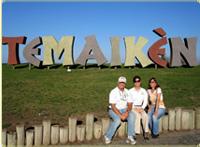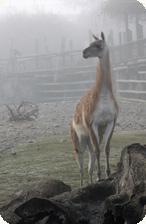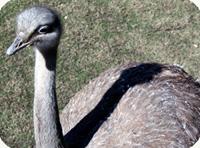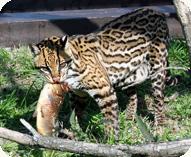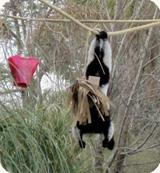A Keeper Conference in Argentina
By Malia Somerville, Beaver Valley Keeper at the National Zoo
At the end of August, Associate Director of Animal Care Sciences Don Moore, Curator of Enrichment and Training Heidi Hellmuth, and I traveled to the Temaiken Biopark outside Buenos Aires (BA), Argentina, to participate in a joint international workshop on animal welfare and wildlife enrichment. I kept a journal of my experiences while attending the workshop.
Day 1: Argentina, here we come! I should have plenty of time to work on my presentations on the plane. Instead I marvel at the views out the plane’s window as we cross the equator, flying over the Amazon rainforest and the foothills of the Andes Mountains. It is winter when we land in Argentina with temperatures in the 60s—a welcome change from the D.C. summer!
Day 2: Temaiken is a beautiful zoo! It is the only zoo in Latin America accredited by the Association of Zoos and Aquariums. Owned by one of the wealthiest families in Argentina, Temaiken is fortunate to have the necessary resources. Temaiken is on par with the most respected zoos in the United States. Even their uniforms are nice—cargo pants and fleece jackets that I would not mind wearing!
We hurriedly review the first presentations. Before we know it, it is time to start. The room fills with people from all over Latin America. With some patience and help from the audience, everything goes well. By lunch we are ahead of schedule—how rare for a conference!
In the afternoon we tour Temaiken’s new bird exhibit. They have several large aviaries for hundreds of flighted birds. Outside, amongst the collection birds are flocks of white-faced whistling ducks and guira cuckoos, species in the collection at the National Zoo that are native and common here. It is wonderful to see the wild counterparts of the animals in our care.
Day 3: We get a late start this morning—we are on Argentine time now! Throughout the day keepers approach us with specific questions and problems. Many of them have the same challenges as we do—destructive elephants, pacing cats and bears, and aggression between conspecifics in social groups. All good questions—we plan a panel question session for later in the day.
My first presentation is at the end of the day. “Making Food Fun” discusses how to make feeding an enriching experience by encouraging animals to work for their food. I am nervous but excited to finally be presenting after hearing many interesting talks already. After several more presentations by professors, doctors, and nutritionists, I take to the podium. Waiting for the interpreter to translate, I look out at the crowd, and it hits me how impressive this type of conference is. We are helping to raise the level of care at institutions across the continent.
Day 4: Like yesterday, the 9 a.m. start time is more of a suggestion. Today most of the presenters are Latinos discussing case studies or specific challenges. I learn as much from them as they have learned from us. For many of the attendees, this is the last day. I can tell everyone is anxious to finish. The staff are starting to look exhausted, too. Before everyone leaves, we are bombarded with requests for advice on a whole host of species. We pass out as many business cards as we can so we can follow up from back in the States. The conference touched the tip of the iceberg!
Day 5: A select group is invited to participate in one more day. I have two presentations but most of the day will be touring Temaiken. First up, "A Day in the Life of a Keeper at the National Zoo." There are a lot of questions about how much training American keepers get, what our educational background is, how much we are paid, etc. As part of the Smithsonian, the National Zoo is unique, but at least it gives them an idea of what keepers in the United States are like. Between sessions we watch cassowary enrichment. The keepers have put fruit pieces on branches in the trees and added a pile of mulch chips for foraging. We are surprised to see the large birds jumping and reaching so high.
Back in the classroom, we put together a workshop activity. We gathered lots of cheap and easy-to-find objects to use for enrichment and give the audience ten minutes to come up with whatever they can. Hay is flying, drills are whirring—someone goes outside to cut their own browse. A lemur keeper selects a few of the creations. We follow her to Temaiken’s Lemur Island to see them in action. The black-and-white lemurs are slow to notice but eventually they investigate. The red-ruffed lemurs jump right in. It is very satisfying to see our work in use.
After lunch we tour the CRET, Temaiken’s reproduction center, much like our Smithsonian Conservation Biology Institute in Front Royal, Virginia. In addition to captive propagation of endangered species and collection animals, the CRET is also a holding facility. For example, a male tiger lives there when he needs to be separated from the female while she is with cubs. Also, birds in training for a free flight bird show are housed in dozens of large runs until they are ready to perform on stage.
Day 9: After a weekend break, we return to BA briefly. We head to the Buenos Aires Zoo first thing on a cold and rainy morning. The BA Zoo is similar to the National Zoo in that it is an older facility with historic structures located in a public park within a large city. They have a dedicated team responsible exclusively for the enrichment and training of all the animals. The passion and determination of the staff more than make up for their physical limitations.
Suddenly, we are back in a cab, off to the airport. I have had an amazing trip but I am ready to go home. I will never forget the people we have met, the animals we have seen, and the lessons we have learned from each other. The heart and spirit of everyone we came into contact with will inspire me for years to come.
This story was originally published in October 2010 issue of Between the Lions, Friends of the National Zoo’s volunteer newsletter.

